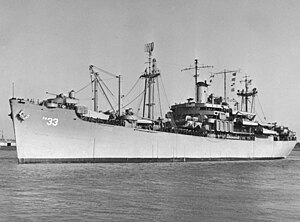Bayfield-class attack transport
 USS Bayfield (APA-33) on 4 January 1950
| |
| Class overview | |
|---|---|
| Name | Bayfield |
| Builders | |
| Operators | |
| Preceded by | Ormsby class |
| Succeeded by | Sumter class |
| In commission | 1943–1945 – 1946–1970 |
| Completed | 34 |
| Active | None |
| General characteristics | |
| Type | Attack transport |
| Displacement | 8,100 tons, 16,100 fully loaded |
| Length | 492 ft 6 in (150.11 m) |
| Beam | 69 ft 6 in (21.18 m) |
| Draft | 26 ft 6 in (8.08 m) |
| Propulsion | Geared turbine drive,[1] 2 × D-type boilers,[2] single propeller, designed shaft horsepower 8,500 |
| Speed | 18 knots (33 km/h; 21 mph) |
| Boats & landing craft carried |
|
| Capacity |
|
| Complement |
|
| Armament |
|
The Bayfield-class attack transport was a class of
With the entry of the United States into the war, it was quickly realized that amphibious combat operations on hostile shores would be required, and that specialized ships would be needed for the purpose. The so-called "attack transport" ship type (
The first attack transports began to enter service in 1942 and were built ad hoc from a host of different types. The first class to be built in substantial numbers was the Bayfield class, which began to enter service in 1943. The early vessels were converted from existing cargo or transport ships, later ones built as attack transports from the keel up.
Overview
Bayfield-class vessels were based on the large
Description

Bayfield-class vessels were based upon the C3-S-A2 design standard. The basic design had to undergo a number of changes in order to meet the attack transport specification.
Troop accommodation
In order to accommodate the troops, two cargo holds amidships had to be converted into accommodation facilities. This was achieved by dividing each hold into three decks, and then building a number of passageways along each deck. Along both walls of each passageway, bunk-beds tiered five high were installed, and each bunk was only thirty inches wide.
The troops were provided with their own galley and mess hall separate from that of the ship's crew, but they had no dining hall and used their own mess gear to eat. A sick bay and dental clinic were also provided. The troop commander had his own private cabin and office, which was fitted with a loudspeaker system from which he could directly address the men under his command. In order to keep the soldiers entertained during their long, crowded voyages, music and other entertainment could be piped to the troop compartments.
Ballast
Because a troop transport carries less weight than a cargo ship, it was also found to be useful to use concrete as ballast in the bottom of the cargo holds in order to improve the comfort level for the ship's passengers, as well as increase safety and seagoing performance.[3]
Weaponry
Since attack transports would be conducting operations off hostile shores, they had a greater requirement for armament than ordinary transports, particularly in regards to antiaircraft defence. The Bayfield-class vessels were well outfitted in this regard. Each vessel was fitted with a pair of
As the war progressed, the 20 mm cannon were found to be less effective than the 40 mm, and the later Gilliam and Haskell classes dispensed with some of these mounts. The later classes also had only one 5-inch (127 mm) gun instead of two.
Production
A total of 34 Bayfield-class vessels were produced between 1942 and 1944 – 20 by Ingalls Shipbuilding of Pascagoula, Mississippi and the remaining 14 at the San Francisco shipyard of Western Pipe & Steel – making the Bayfield class the second most numerous attack transport class behind the Haskell class.
Service
Bayfield-class vessels served in both the
Of the 388 attack transports (APA and AKA) of all types built, the last to see service with the US Navy was USS Chilton,[4] a Bayfield-class vessel built by Western Pipe & Steel which was launched on 29 December 1942, first commissioned on 7 December 1943 and decommissioned in August 1970. She was finally struck from the Navy register on 1 July 1972.
Footnotes
- Westinghouse.
- ^ Built by Combustion Engineering, Foster Wheeler or Babcock & Wilcox.
- ^ Information for the "Ballast" and "Troop accommodation" sections comes from Maudsley, pp 75–76 (see references below).
- ^ Mawdsley, page 141.
References
- Bayfield-class specifications, DANFS Online (See class specifications. Note: the specification for a single 5"/38 gun is apparently a typo here, the Bayfield class had two of these guns as standard. Other specifications are correct).
- USS Bayfield (a typical Bayfield-class ship), Navsource Online.
- Mawdsley, Dean L. (2002): Steel Ships and Iron Pipe: Western Pipe and Steel Company of California, the Company, the Yard, the Ships, ISBN 1-889901-28-8.
